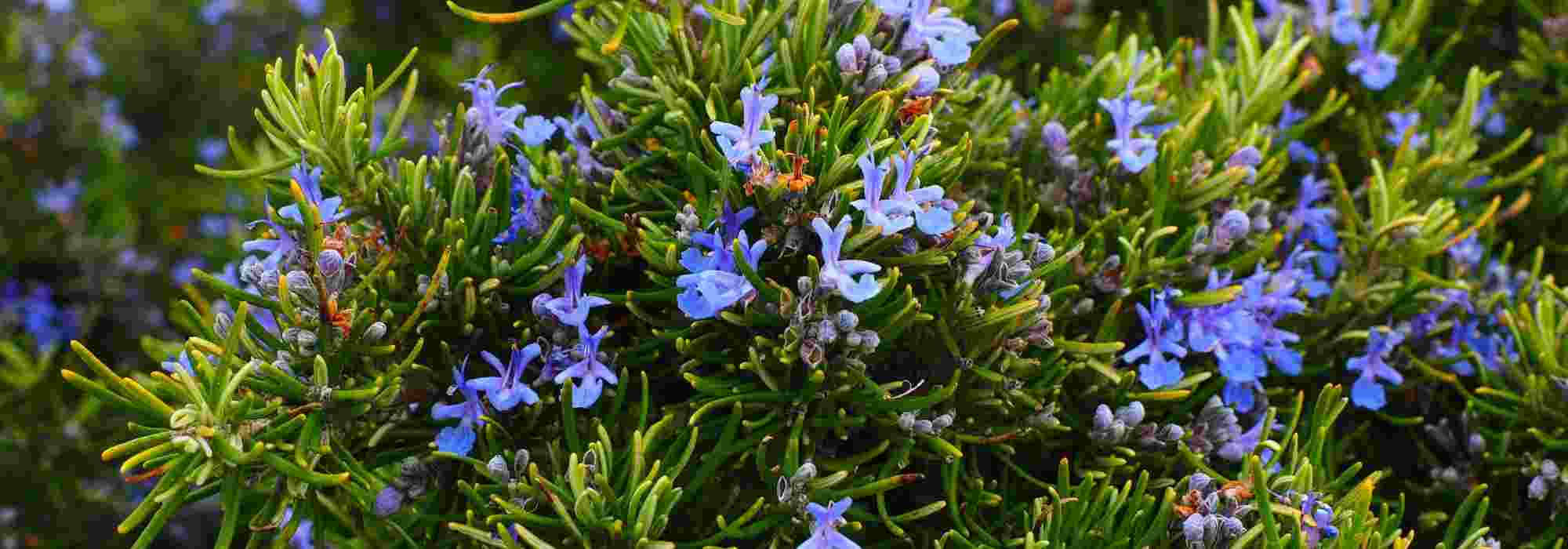
What can be planted on a south-facing terrace?
Selection of perennials and shrubs for outdoor
Contents
A south-facing terrace is a boon for all plants that enjoy sun and cope well with heat and drought. Most often, in the absence of a tree stratum providing shade and with heat retained by typically hard surfaces, it is therefore best to choose plants that tolerate full heat. Wind should also be taken into account when you have an apartment terrace. For a house terrace, opt instead for a large bush that provides shade and does well in a pot. In any case, as the terrace usually offers a view from the main living room, it is worth favouring evergreen plants, whose ornamental potential will be prolonged, and, in urban settings, some screening plants. Lavender officinalis (Lavandula angustifolia) will find its place in all regions thanks to its great hardiness, but other plants also have much to offer on an exterior exposed to the strongest sun rays.
Bringing colour, exuberance or volume, medium-sized bushes and interest both in foliage and flowering… we offer some drought-tolerant plants that perform well in pots on south-facing terraces, for different atmospheres that will delight your terrace for many months.
Perennials
Among many perennials you can invite onto your south-facing terrace, here is a top 3 we particularly recommend for their heat tolerance, their magnificent long flowering, and their suitability for pot culture :
Agapanthus ‘Silver Moon’ : a holiday feel on the terrace
With their very graphic blue or white umbels, Agapanthus are perfect plants to brighten a terrace for many weeks in summer. As they like being a little cramped and thrive in full sun (they really need it for optimum flowering), a generous container on a south-facing terrace suits these beautiful South African rhizomatous plants perfectly. Considered tender, opt for a deciduous species if you cannot bring your container undercover in winter and you live in a very rainy region (Agapanthus actually mainly dread winter dampness), as they will be hardier. Agapanthus ‘Silver Moon’ is a magnificent cultivar with flowers of a lovely violet-blue and unusually ribboned leaves variegated with cream, giving it silvery notes. Flower stems are carried on stalks about 70 cm tall, giving it a striking presence in a large container. It tolerates temperatures down to -15°C. As with all Agapanthus, ‘Silver Moon’ will need a particularly well-drained substrate. To complete the summery atmosphere on your terrace, surround it with other deciduous varieties like it or with evergreens to create a massed effect, and add a few evergreens: a Phormium echoing the ribboned foliage, an Arbutus unedo ‘Compacta’, Artemisia to pick up the silvery tones, or, for a light contrast, a Gypsophila ‘Bristol Fairy’.
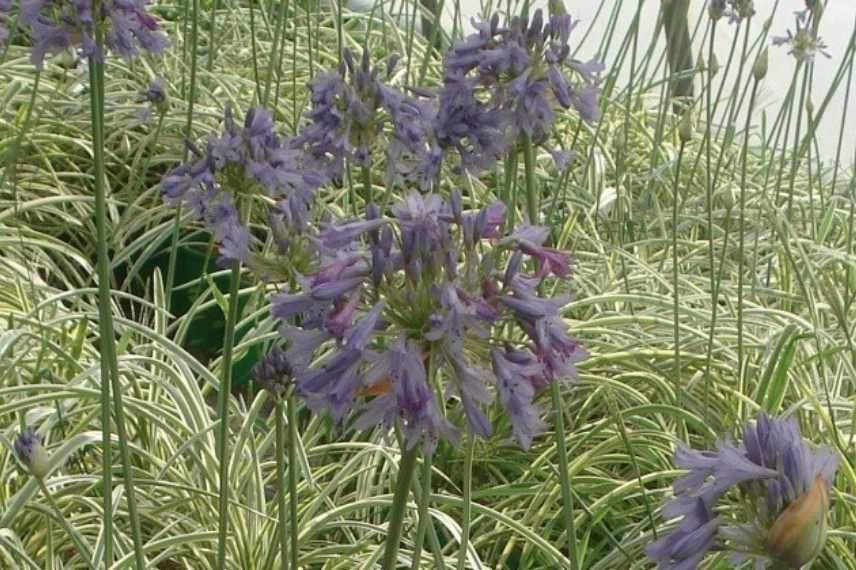
Agapanthus ‘Silver Moon’
→ Discover our selection of Agapanthus for pots
Osteospermums : gorgeous but tender
Also known by the pretty name Cape daisies, these are superb perennials that will enliven a container on your south-facing terrace: they really enjoy it there, needing at least 6 hours’ sun to flower abundantly and turn into a colourful cushion all summer, especially if you deadhead them to encourage new flower buds. Place them ideally in a slightly tall container, where they will drape or spill beautifully. Their flowers show great diversity in colours and shapes, some even surprising with an exotic look thanks to their spatulate petals. You can even forget to water them occasionally; they will not suffer much… They are best in mild-climate regions, as they do not tolerate frosts below about 8°C, but they retain their foliage without severe cold, which makes them particularly appealing.

Osteospermums : charming and very original
Sedum spectabile : ultra-hardy succulents!
Autumn stonecrops are magnificent perennials that will enchant your terrace just as other flowerings become scarcer from late August. Before then, they charm for months with their fleshy rosette leaves reminiscent of succulents, bluish or purple on some varieties. They gradually add volume, initially forming cushions from March or April, then rising progressively to carry their flowers on stems about 60 cm. I particularly love their succulent aspect, and above all their ability to flower late, with flattened inflorescences made up of a multitude of star-like blooms in often very soft colours. They are perfectly hardy, and perform wonderfully on a terrace… Plant them in handsome terracotta pots.
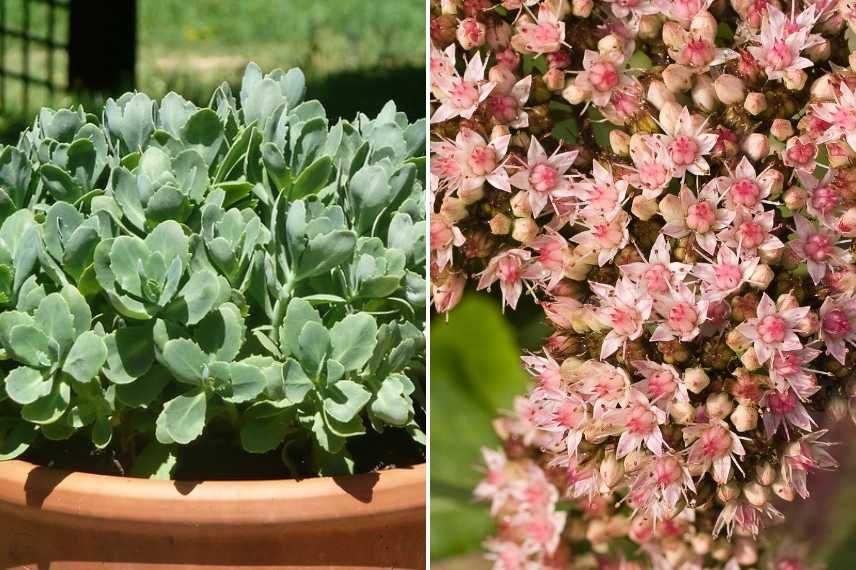
Sedum spectabile in spring (© Christina Sanvito), and the flowering of Sedum spectabile ‘Matrona’
→ Discover our full sheet: Sedum or orpin: how to plant, cultivate and propagate them
Phormium tenax : for an exotic terrace
If you want a plant on your sunny terrace that alone will give a lot of character and impart an exotic feel, Phormium tenax is for you! This structural plant is associated with mild climates, but Phormium tenax tolerates down to -10°C once established. It is sculptural in a pot or a sufficiently wide container to accommodate its extraordinary upright silhouette. The bright green, evergreen leaves stand almost vertical; they are tough and highly graphic, bringing a lot of dynamism and presence. In a container its dimensions remain restrained, reaching at most 1.5 m high and as wide. It is perfect by the sea as it tolerates wind and sea spray. However, not recommended if you have young children, as the tips of its leaves are sharp…
If you want to enhance the exotic look and plunge into exuberance, add large glossy leaves such as a dwarf banana, and complement with an Opuntia, a Dasylirion ‘Wheeleri’, and a palm Chamaerops humilis ‘Vulcano’, magnificent in a large container with its blue-green fronds. A few Eucomis that like being a bit crowded in a pot will ensure a very exotic late-summer flowering on your terrace.

Phormium tenax
→ Other suggestions of perennials for a south-facing position in our article.
Shrubs
Oleander: on a romantic terrace
If there is one bush that copes particularly well with a very sunny terrace, and whose long flowering lets you enjoy it all summer, it is oleander. Variety ‘Papa Gambetta’ is hardy to -10°C, ‘Atlas’ to -16°C… enough reason not to miss out, especially since a sheltered south-facing position really protects it over winter. If you can overwinter it in a bright frost-free room, that’s preferable in harsher regions; otherwise, protect it by following our advice. Like most plants in this selection, it needs very well-draining soil. It brings plenty of romance, but is also perfect for a Mediterranean-style terrace.
Pair it with plants unfazed by strong midsummer sun and suited to container culture: a Choisya ‘Aztec Pearl’, a Gaura lindheimeri, a Verbena bonariensis ‘Lollipop’, a Deutzia gracilis, etc.
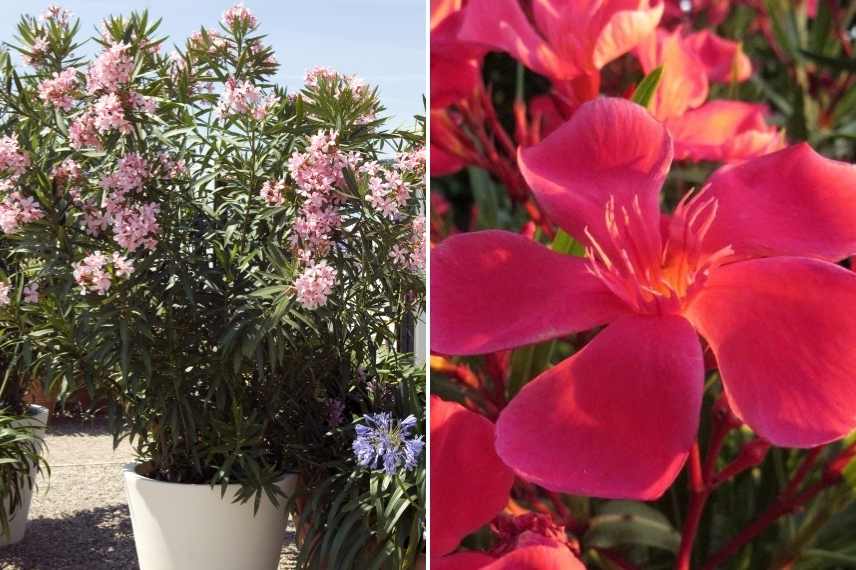
Oleander in a pot. On right cultivar ‘Papa Gambetta’
Escallonia ‘Donard Radiance’: an essential for all terrace styles
Escallonias are small sun-loving bushes not often used, yet they prove to be perfect subjects for container planting that can be put away in regions with very cold winters. By choosing an evergreen variety such as ‘Donard Radiance’, you bring to your terrace very ornamental glossy dark green foliage all year, a long and abundant flowering during July and August, and you benefit from its strong vigour. Flowers are small but open in profusion. The Escallonia ‘Donard Radiance’ keeps a compact habit, with maximum height in a pot of 1.50 m. It blends perfectly into a contemporary style and integrates beautifully into a more bohemian terrace when surrounded by softer plants. A Vitex agnus-castus ‘Blue Puffball’, very hardy, compact and therefore well suited to a pot, can join it, contrasting nicely with its deep lavender-blue. A Pittosporum (or several if you are a fan like me!) will have a strong impact with its highly decorative foliage.

Escallonia ‘Donard Radiance’
Lagerstroemia: a small ornamental tree and living sculpture
If you want to add more height to your outdoor space, while keeping volumes moderate, a compact variety of Lagerstroemia (crape myrtle) can be an ideal terrace companion: it needs sun and heat to flower well, and adapts nicely to container planting. It flowers late in the summer, but for a long time until frosts. Some varieties have magnificent purple foliage, and an elegant, crumpled flowering in white and in every shade of pink. It is the small tree that will really make an impact on your terrace, especially as it takes beautiful autumn colours, and in winter, once its leaves have fallen, it becomes a small plant sculpture thanks to beauty of its habit and its bark.
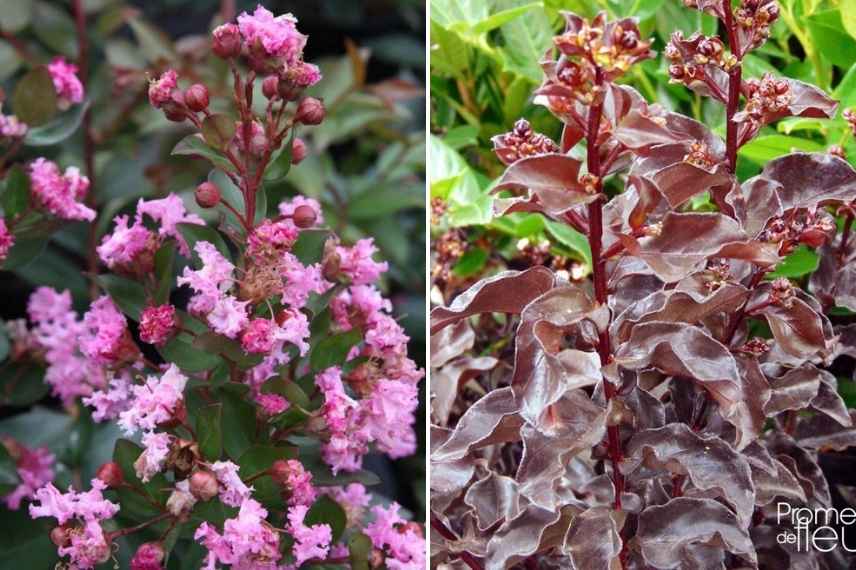
Two compact hardy crape myrtles: Lagerstroemia ‘Mardi Gras’, and Lagerstroemia ‘Black solitaire Best Red’
Rosmarinus officinalis: with Mediterranean accents
Don’t hesitate to give your terrace a touch of garrigue with a rosemary: its handsome evergreen silvery foliage, with narrow small leaves, and its erect shoots provide interesting volume all year. Its long flowering is delightful, the bush becoming covered in a myriad of small flowers in varying shades of violet-blue, and it has the advantage of brightening your outdoor space several times a year (in winter, in spring; it often re-blooms in summer or autumn). It is quite hardy, coping as well with winter cold as with blazing midsummer sun. It is a shrub I recommend because it performs very well in a tall pot filled with draining substrate, and it is unfazed by sea spray and drought. In a very tall pot, choose a trailing rosemary that will spill beautifully, otherwise a Rosmarinus officinalis. As it is extremely melliferous, attracting pollinators fond of its nectar, place your pot a little away from dining area. Lavenders, sages and Leptospermum in separate pots accompany it magnificently. Even though, in my view, an olive tree remains best planted in the ground, it can complete a large southern terrace.
In mild climates, you can even pair it with its southern-hemisphere cousin, Westringia, whose more spreading habit and mauve or white tones will add to the Mediterranean feel of your terrace.
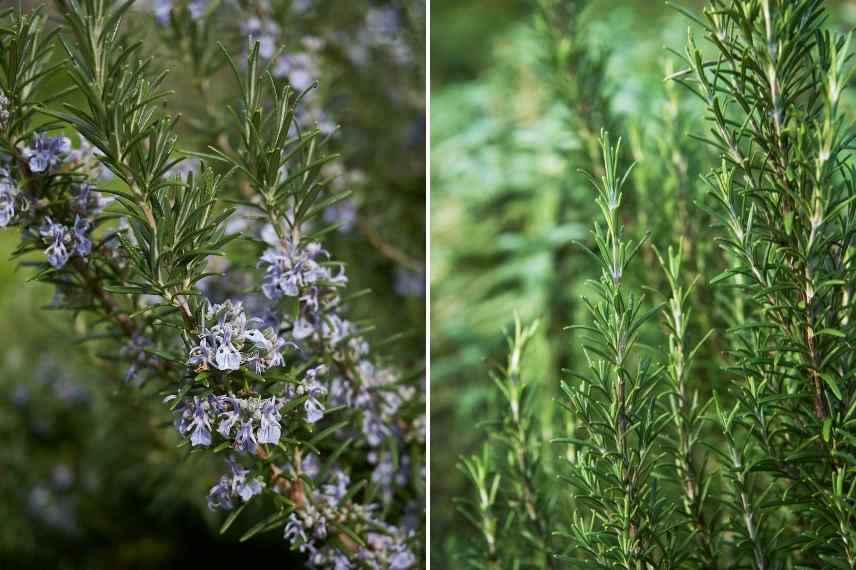
Rosmarinus officinalis, flowering and habit
Discover other Patio shrubs
View all →Available in 1 sizes
Available in 1 sizes
Available in 0 sizes
Available in 0 sizes
Available in 0 sizes
Available in 0 sizes
Available in 0 sizes
Available in 0 sizes
Available in 0 sizes
Grasses
Miscanthus sinensis ‘Morning Light’ : on a contemporary terrace
Miscanthus love sun; a south-facing position doesn’t worry them! Although often associated with garden plantings, Chinese silvergrass is also a great choice for contemporary terraces, as these grasses perform very well in large pots. The habit of Miscanthus sinensis, both supple and architectural, fits perfectly into a clean, modern setting. You can choose from many varieties which, depending on their height, can also serve as an effective screen on an elevated urban terrace. They are also perfectly hardy, although you should protect the stump as a precaution on a terrace during the first few years. In short… Miscanthus sinensis is a must for a design-led terrace. My favourite for this use is the elegant Miscanthus sinensis ‘Morning Light’ with its upright habit that remains both graphic and delicate: reaching 1.7 m when it flowers in late summer, it’s perfect for adding a slightly silvery green vertical element, nuanced by the airy pinkish then white flowers. With a few pots of low grasses (Stipa tenuifolia, blue fescues, Carex), and taller ones (Pennisetums) you complete a 100% grass terrace; with verticals you further enhance the design aspect (Euonymus ‘Benkomasaki’, Juniperus communis ‘Gold Cone’). In a container that you should choose large (no less than 60 cm diameter for 80 cm depth), make sure to water regularly during the first two years.
→ Discover our range of grasses for pots and our selection of grasses for pots
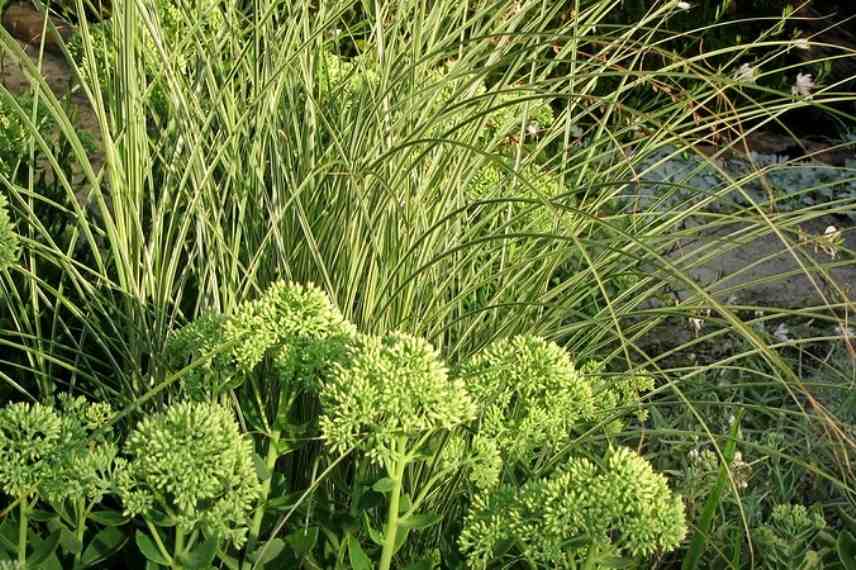
Miscanthus ‘Morning Light’, Sedum ‘Autumn Fire’, in August (© Cultivar 413)
To go further
Discover more ideas to enhance a terrace :
- North-facing: What can be planted on a north-facing terrace?
- East-facing: What can be planted on an east-facing terrace?
- Subscribe!
- Contents
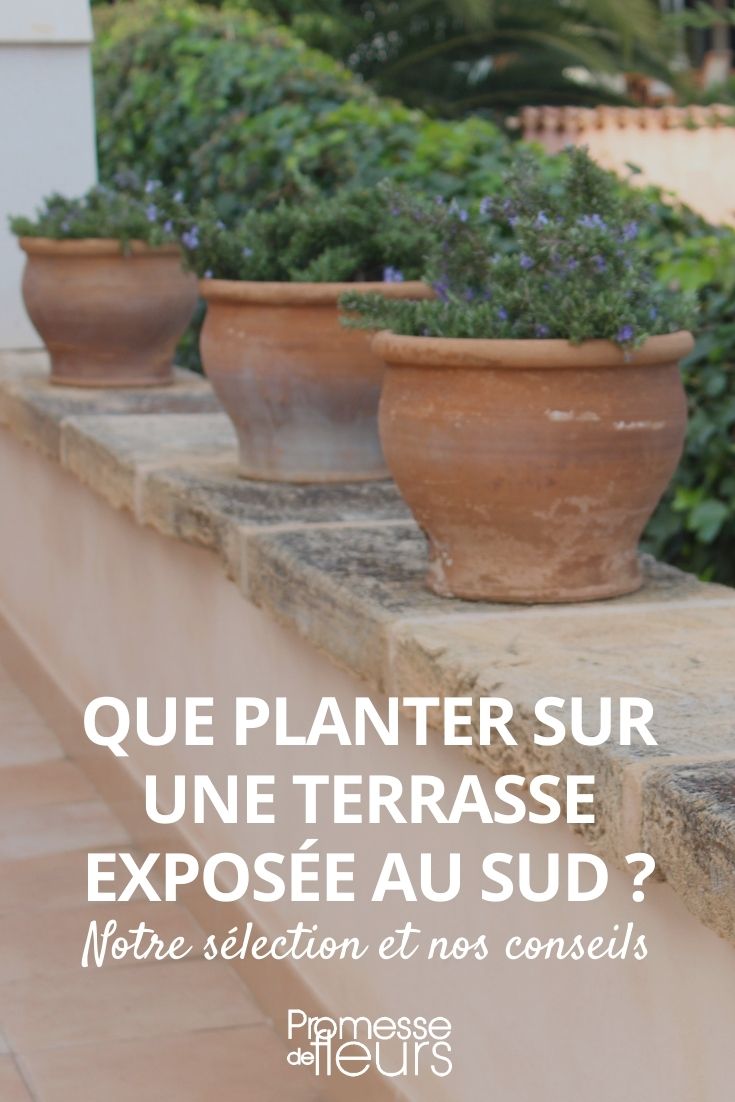































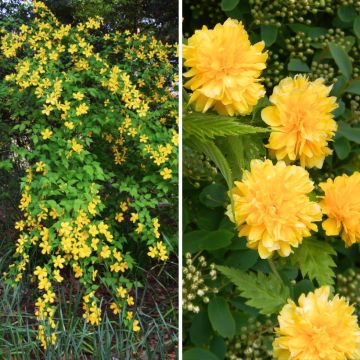
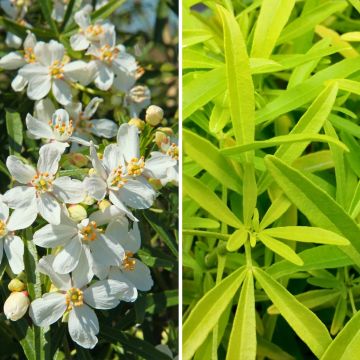

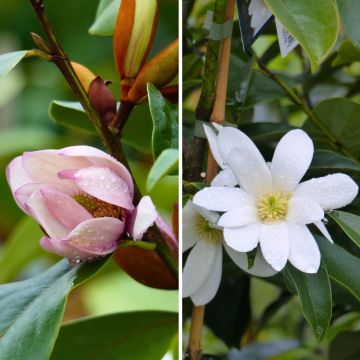
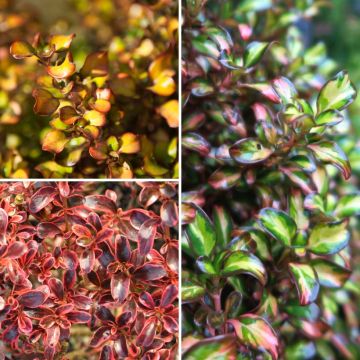
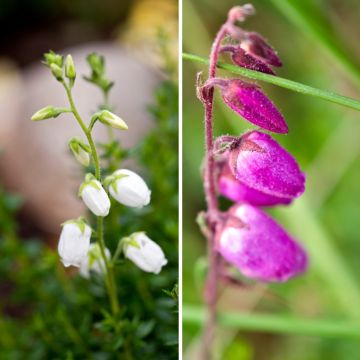
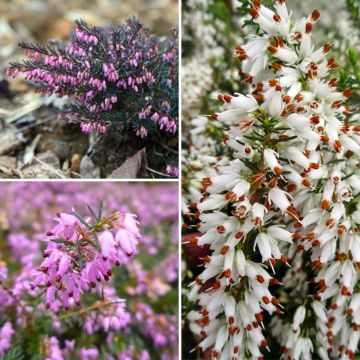
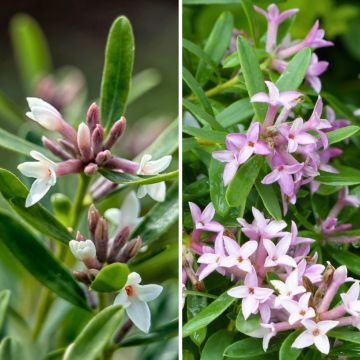
Comments